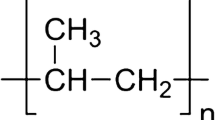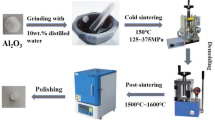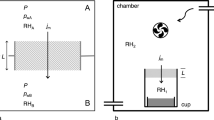Abstract
Open ceramic foams are usually constituted of three-dimensional networks with randomly interconnected solid struts and fluid within pores. The heat transport within this material can be understood as the coupling of conduction, convection as well as radiation. The cooperative control of different heat transfer mechanisms is critical to successful design and optimization of components working at high temperatures. An answer to this problem usually requires good knowledge and understanding of the corresponding thermal properties in a wide range of temperatures. In the present paper, an inverse identification method was developed to determine coupled thermal properties from transient thermal measurements at temperatures up to 900 K for full description of conduction/radiation heat transports of foam media with absorbing, emitting, and anisotropic scattering effects. The influence of postulated phase function on the identified equivalent extinction coefficient, scattering albedo, anisotropic scattering factor, and two-phase thermal conductivity was discussed for better understanding of thermal behavior within ceramic foams. The estimated thermal properties under each postulated phase function of the sample at transient temperature profiles were used to calculate equivalent thermal conductivities, which were then compared with the measured results at more than 1000 K. The accordance between them indicated that linear anisotropic scattering phase function demonstrates superiority in description of radiation behavior within Al2O3 ceramic foam.










Similar content being viewed by others
Abbreviations
- C :
-
Specific heat of the sample (J·kg−1·K−1)
- g :
-
Anisotropic scattering factor of phase function
- \( \tilde{g} \) :
-
Equivalent scattering factor of phase function
- I :
-
Total radiation intensity (W·m−2)
- I b :
-
Total blackbody radiation intensity (W·m−2)
- krad :
-
Radiative thermal conductivity (W·m−1·K−1)
- L :
-
Thickness of ceramic foam sample (m)
- q c :
-
Conductive heat flux (W·m−2)
- q r :
-
Radiant heat flux (W·m−2)
- t :
-
Time (s)
- T :
-
Temperature (K)
- T 0 :
-
Initial temperature (K)
- T cold :
-
Cold surface temperature (K)
- T hot :
-
Hot surface temperature (K)
- x :
-
Spatial coordinate through the sample thickness (m)
- β :
-
Extinction coefficient (m−1)
- β * :
-
Weighted extinction coefficient (m−1)
- \( \tilde{\beta } \) :
-
Equivalent extinction coefficient (m−1)
- \( \tilde{\varvec{\beta }}^{\varvec{ * }} \) :
-
Weighted equivalent extinction coefficient (m−1)
- ε 1 :
-
Emissity of the upper bounding surface
- ε 2 :
-
Emissity of the lower bounding surface
- θ :
-
Polar angle rad
- Θ:
-
Scattering angle rad
- λ two- phase :
-
Two-phase thermal conductivity (W·m−1·K−1)
- \( \tilde{\lambda }_{{two{ - }phase}} \) :
-
Equivalent two-phase thermal conductivity (W·m−1·K−1)
- μ :
-
Cosine of the angle between x-axis and direction of radiation propagation
- μ′:
-
Cosine of the angle between x-axis and another direction of radiation
- ρ :
-
Density (kg·m−3)
- σ :
-
Stefan–Boltzmann constant (W·m−2·K−4)
- σ a :
-
Absorption coefficient (m−1)
- σ s :
-
Scattering coefficient (m−1)
- \( \sigma_{s}^{*} \) :
-
Weighted scattering coefficient (m−1)
- Φ:
-
Scattering phase function
- \( {\tilde{\varPhi}} \) :
-
Equivalent scattering phase function
- ω :
-
Scattering albedo
- \( \omega^{*} \) :
-
Weighted scattering albedo
- \( \tilde{\omega } \) :
-
Equivalent scattering albedo
- \( \tilde{\varvec{\omega }}^{\varvec{*}} \) :
-
Weighted equivalent scattering albedo
References
A. Ortona, S. Gianella, D. Gaia, SIC foams for high temperature applications, in Advances in Bioceramics and Porous Ceramics IV: Ceramic Engineering and Science Proceedings (2011), pp. 153–161
W.G. Xu, H.T. Zhang, Z.M. Yang, J.S. Zhang, The effective thermal conductivity of three-dimensional reticulated foam materials. J. Porous Mater. 16, 65–71 (2009)
M. Wang, N. Pan, Modeling and prediction of the effective thermal conductivity of random open-cell porous foams. Int. J. Heat Mass Transf. 51, 1325–1331 (2008)
M.A. Mendes, S. Ray, D. Trimis, A simple and efficient method for the evaluation of effective thermal conductivity of open-cell foam-like structures. Int. J. Heat Mass Transf. 66, 412–422 (2013)
M.A. Mendes, S. Ray, D. Trimis, An improved model for the effective thermal conductivity of open-cell porous foams. Int. J. Heat Mass Transf. 75, 224–230 (2014)
M.A. Mendes, S. Ray, D. Trimis, Evaluation of effective thermal conductivity of porous foams in presence of arbitrary working fluid. Int. J. Therm. Sci. 79, 260–265 (2014)
R. Singh, H.S. Kasana, Computational aspects of effective thermal conductivity of highly porous metal foams. Appl. Therm. Eng. 24, 1841–1849 (2004)
R. Coquard, D. Baillis, Numerical investigation of conductive heat transfer in high-porosity foams. Acta Mater. 57, 5466–5479 (2009)
G.N. Dulnev, Heat transfer through solid disperse systems. J. Eng. Phys. Thermophys. 9, 275–279 (1965)
A. Bhattacharya, V.V. Calmidi, R.L. Mahajan, Thermophysical properties of high porosity metal foams. Int. J. Heat Mass Transf. 45, 1017–1031 (2002)
L.R. Glicksmann, M.A. Schuetz, Low Density Cellular Plastics (Chapman & Hall, London, 1994), pp. 104–152
R. Coquard, D. Rochais, D. Baillis, Conductive and radiative heat transfer in ceramic and metal foams at fire temperatures. Fire Technol. 48, 699–732 (2012)
P. Ranut, On the effective thermal conductivity of aluminum metal foams: review and improvement of the available empirical and analytical models. Appl. Therm. Eng. 101, 496–524 (2016)
P. Kumar, F. Topin, J. Vicente, Determination of effective thermal conductivity from geometrical properties: application to open cell foams. Int. J. Therm. Sci. 81, 13–28 (2014)
P. Kumar, F. Topin, Simultaneous determination of intrinsic solid phase conductivity and effective thermal conductivity of Kelvin like foams. Appl. Therm. Eng. 71, 536–547 (2014)
B. Dietrich, G. Schell, E.C. Bucharsky, R. Oberacker, M.J. Hoffmann, W. Schabel, M. Kind, H. Martin, Determination of the thermal properties of ceramic sponges. Int. J. Heat Mass Transf. 53, 198–205 (2010)
J. Randrianalisoa, D. Baillis, C.L. Martin, R. Dendievel, Microstructure effects on thermal conductivity of open-cell foams generated from the Laguerree Voronoï tessellation method. Int. J. Therm. Sci. 98, 277–286 (2015)
C.Y. Zhao, T.J. Lu, H.P. Hodson, Thermal radiation in ultralight metal foams with open cells. Int. J. Heat Mass Transf. 47, 2927–2939 (2004)
L.R. Glicksman, J. Steward, The measurement of the morphology of closet cell which control the overall thermal conductivity, in Third Symposium on Insulation Materials: Testing and Applications (ASTM, Quebec, 1997), pp. 307–334
D. Doermann, J.F. Sacadura, Heat transfer in open cell foam. ASME J. Heat Transf. 118, 88–93 (1996)
J. Kuhn, H.P. Ebert, M.C. Arduini-Schuster, D. Büttner, J. Fricke, Thermal transport in polystyrene and polyurethane foam insulations. Int. J. Heat Mass Transf. 35, 1795–1801 (1992)
E. Placido, M.C. Arduini-Schuster, J. Kuhn, Thermal properties predictive model for insulating foams. Infrared Phys. Technol. 46, 219–231 (2005)
R. Coquard, D. Baillis, D. Quenard, Radiative properties of expanded polystyrene foams. J. Heat Transf. 131, 012702.1–012702.10 (2009)
C. Tseng, A.D. Swanson, R. Viskanta, R.L. Sikorski, M.Y. Chen, Effect of foam properties on radiative properties of open-cell silicon carbide foams. J. Quant. Spectrosc. Radiat. Transf. 113, 1503–1507 (2012)
P. Parthasarathy, P. Habisreuther, N. Zarzalis, Identification of radiative properties of reticulated ceramic porous inert media using ray tracing technique. J. Quant. Spectrosc. Radiat. Transf. 113, 1961–1969 (2012)
S. Cunsolo, M. Oliviero, W.M. Harris, A. Andreozzi, N. Bianco, W.K.S. Chiu, V. Naso, Monte Carlo determination of radiative properties of metal foams: comparison between idealized and real cell structures. Int. J. Therm. Sci. 87, 94–102 (2015)
B. Dietrich, T. Fischedick, S. Heissler, P. Weidler, C. Wöll, M. Kind, Optical parameters for characterization of thermal radiation in ceramic sponges—experimental results and correlation. Int. J. Heat Mass Transf. 79, 655–665 (2014)
T. Fischedick, M. Kind, B. Dietrich, High temperature two-phase thermal conductivity of ceramic sponges with stagnant fluid—experimental results and correlation including thermal radiation. Int. J. Therm. Sci. 96, 1–11 (2015)
R. Coquard, D. Rochais, D. Baillis, Modelling of the coupled conductive and radiative heat transfer in NiCrAl foams from phothothermal measurements and X-ray tomography. Spec. Top. Rev. Porous Media 2, 249–265 (2011)
R. Coquard, B. Rousseau, D. Baillis, H. Gomart, Investigations of the radiative properties of Al–NiP foams using tomographic images and stereoscopic micrographs. Int. J. Heat Mass Transf. 55, 1606–1619 (2012)
S. Cunsolo, R. Coquard, D. Baillis, Wilson.K.S. Chiu, Nicola. Bianco, Radiative properties of irregular open cell solid foams. Int. J. Therm. Sci. 117, 77–89 (2017)
B. Zeghondy, E. Iacona, J. Taine, Determination of the anisotropic radiative properties of a porous material by radiative distribution function identification (RDFI). Int. J. Heat Mass Transf. 49, 2810–2819 (2006)
B. Zeghondy, E. Iacona, J. Taine, Experimental and RDFI calculated radiative properties of a mullite foam. Int. J. Heat Mass Transf. 49, 3702–3707 (2006)
M. Tancrez, J. Taine, Direct identification of absorption and scattering coefficients and phase function of a porous medium by a Monte Carlo technique. Int. J. Heat Mass Transf. 47, 373–383 (2004)
J. Petrasch, P. Wyss, A. Steinfeld, Tomography-based Monte Carlo determination of radiative properties of reticulate porous ceramics. J. Quant. Spectrosc. Radiat. Transf. 105, 180–197 (2007)
T.J. Hendricks, J.R. Howell, Absorption/scattering coefficients and scattering phase functions in reticulated porous ceramics. J. Heat Transf. 118, 79–87 (1996)
D. Baillis, M. Raynaud, J.F. Sacadura, Determination of spectral radiative properties of open cell foam: model validation. J. Thermophys. Heat Transf. 14, 137–143 (2000)
M.J. Hale, M.S. Bohn, Measurement of the radiative transport properties of reticulated alumina foams, in ASME/ASES Joint Solar Energy Conference, Washington DC (USA) (1993), pp. 507–515
P.F. Hsu, J.R. Howell, Measurements of thermal conductivity and optical properties of porous partially stabilized zirconia. Exp. Heat Transf. 5, 293–313 (1992)
R. Coquard, D. Rochais, D. Baillis, Experimental investigations of the coupled conductive and radiative heat transfer in metallic/ceramic foams. Int. J. Heat Mass Transf. 52, 4907–4918 (2009)
M. Grujicic, C.L. Zhao, S.B. Biggers, J.M. Kennedy, D.R. Morgan, Heat transfer and effective thermal conductivity analyses in carbon-based foams for use in thermal protection systems. Proc. Inst. Mech. Eng. L J. Mater. Des. Appl. 219, 217–230 (2006)
C.C. Tseng, R.L. Sikorski, R. Viskanta, M.Y. Chen, Effect of foam properties on heat transfer in high temperature open-cell foam inserts. J. Am. Ceram. Soc. 95, 2015–2021 (2012)
D.W. Marquardt, An algorithm for least-squares estimation of non-linear parameters. J. Soc. Ind. Appl. Math. 11, 431–441 (1963)
S.Y. Zhao, B.M. Zhang, S.Y. Du, An inverse analysis to determine conductive and radiative properties of a fibrous medium. J. Quant. Spectrosc. Radiat. Transf. 110, 1111–1123 (2009)
K. Daryabeigi, Heat Transfer in High-Temperature Fibrous Insulation. AIAA Paper 2002-3332
M.F. Modest, Radiative Heat Transfer, International Edition, 2nd edn. (McGraw Hill, New York, 2003), pp. 225–250
E.M. Sparrow, R.D. Cess, Radiation Heat Transfer, Augmented edition (McGraw-Hill, New York, 1978), pp. 255–271
Acknowledgements
This work was supported by Pre-research Key Laboratory Foundation of General Armament Department of China (Grant No. JZ20180035).
Author information
Authors and Affiliations
Corresponding authors
Appendix
Appendix
The transient temperature responses in the medium can be obtained by solving nonlinear energy equation in combination with radiative transfer equation. The following assumptions are introduced for this research: 1) a plane-parallel, open-cellular porous plate is installed horizontally and bounded by two opaque diffuse solid plates; 2) the porous plate is heated from above and cooled from below; 3) heat transfer across the plate is due to conduction and radiation; 4) the porous plate is homogeneous and capable of emitting, absorbing and anisotropically scattering thermal radiation; and 5) there exists unique equivalent value for each thermal parameter in the entire temperature range of interest to substitute the real thermal property for simulation of global equivalent thermal behavior of material. Under these assumptions, the energy equation can be written as follows [46, 47]:
Mathematically, the initial and thermal boundary conditions are thus the following:
The conductive heat flux qc is defined by:
Given the radiation intensity at each point of the medium, in each direction and at each time, the radiative heat flux qr is then defined by:
The radiation intensity field in an absorbing-emitting-scattering gray medium is governed by the radiative transfer equation (RTE). For a 1D radiation heat transfer, the RTE can be expressed by [46]
In Eq. 10, the terms on the right-hand side describe, respectively, the extinction phenomena, the internal emission and the intensity of the scattering in the μ direction.
When the surface bounding of the medium is gray and emits and reflects diffusely, then the radiative boundary conditions for Eq. 10 are given by
Rights and permissions
About this article
Cite this article
Zhao, S., Sun, X., Que, Q. et al. Influence of Scattering Phase Function on Estimated Thermal Properties of Al2O3 Ceramic Foams. Int J Thermophys 40, 11 (2019). https://doi.org/10.1007/s10765-018-2473-1
Received:
Accepted:
Published:
DOI: https://doi.org/10.1007/s10765-018-2473-1




